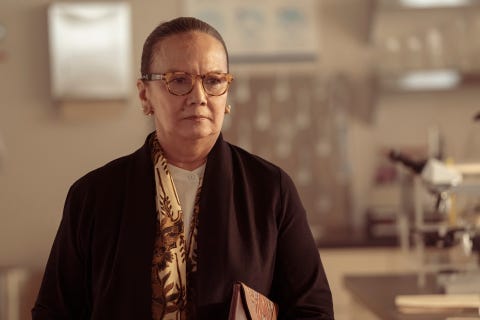How Cordyceps Found Its Ground Zero in 'The Last of Us', Explained
A little background reading on the IRL killer fungi 'cordyceps' (or a chat with the biology professor who helped the game developers realistically portray it) might have you thinking that it’s only a matter of until the fungus infects –and subsequently dooms – humankind.
But while we're still (hopefully) a long, long way off the point where spores take over our bodies and use them for their own evil gain, it's happening right now in the fictional world of The Last of Us. In fact, in episode two, we begin to learn exactly what happened to place the human race in such a hellscape.
Who was patient zero in The Last Of Us and what happened?Nothing gets past the eagle-eyed fans over on TLOU Reddit, as one viewer noted several beats in the intro that raised eyebrows: no one was eating any carbs or grains.
“Sarah has no flour for pancakes so they make eggs. They refuse the biscuits. Joel is on the Atkins diet (similar to the keto with no carbs). Sarah doesn't take any cookies because of raisins. Joel forgets to get a birthday cake.”
A reach? Well, no. Showrunner Craig Mazin then revealed in a podcast that there were a lot of “breadcrumbs” in the episode to discover. Add that to the fact the world’s largest flour mill is in Jakarta, and the radio in episode one, pre-plague, said that there were riots breaking out in the Indonesian capital, and all the signs were there.
Episode two starts pleasantly enough, pre-pandemic, where an older woman, Ibu Ratna, is having her lunch, when some police arrive to take her away. We learn she’s a professor of mycology (the study of fungi) and she’s taken into a laboratory to examine a sample.

HBO
It’s Ophiocordyceps unilateralis, she confirms, but she wants to know why chlorazol (a dye that’s commonly used to identify fungal elements from human hair or nails), was used to prepare the slide. She’s told that’s because it’s from a human, which she says is impossible, that cordyceps cannot survive in our bodies.
Except, she’s then taken in to see a dead body. Hazmat-suited up, she probes the female cadaver, finding a human bite on her leg. Then she pulls out crawling tendrils from the mouth, and, quite rightly, legs it.
The guard then tells her that 30 hours earlier in a “flour and grain factory on the west side of the city” a normal woman became violent and attacked co-workers and bit three of them. They managed to lock her in a bathroom until police came, but she tried to attack them so they shot her. Her bitten colleagues were then executed, but the professor sagely notes that the person who bit her was still on the loose, as well as 14 other co-workers.
There’s no vaccine or medicine to cure this, the professor tells them. There’s just one solution: bomb the whole city and everyone in it.
The game has a different ground zero for the fungi getting into the food chain, and it’s based in South America. When Joel and his daughter Sarah are living in Austin, we read a copy of the Texas Herald with the headline: ‘Admittance spikes at area hospitals! 300% increase due to mysterious infection’.
Another article then details: “The Food and Drug Administration's investigation of crops potentially tainted with mold continues across the country. Initial lists distributed to vendors nationwide warned against crops imported from South America, but now the scope has extended to include Central America and Mexico. Several companies have already voluntarily recalled their food products from the shelves.”
Different country, same horrific outcome. It’s enough to make you want to join Joel on the Atkins diet.
The Last Of Us continues weekly on Sky Atlantic and NOW TV.













































